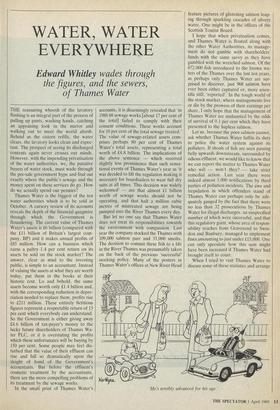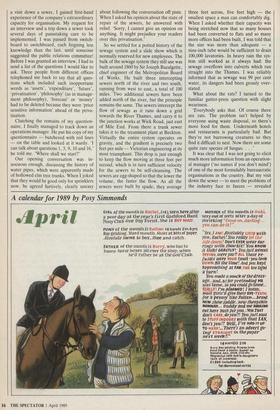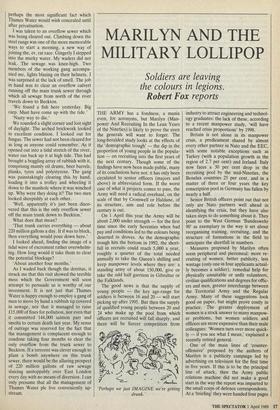WATER, WATER EVERYWHERE
Edward Whitley wades through
the figures, and the sewers, of Thames Water
THE reassuring whoosh of the lavatory flushing is an integral part of the process of pulling up pants, washing hands, catching an appraising look in the mirror and walking out to meet the world afresh. Behind us the cistern refills, the water clears, the lavatory looks clean and expec- tant. The prospect of seeing its discharged contents again never crosses our minds. However, with the impending privatisation of the water authorities, we, the putative buyers of water stock, must wade through the pre-sale government hype and find out exactly where the public's sewage and the money spent on these services do go. How do we actually spend our pennies?
Thames Water is the biggest of the ten water authorities which is to be sold in October. A cursory review of its accounts reveals the depth of the financial quagmire through which the Government is floundering. The current value of Thames Water's assets is £6 billion (compared with the £11 billion of Britain's largest com- pany, BP) and it makes annual profits of £85 million. How can a business which earns a paltry 1.4 per cent return on its assets be sold on the stock market? The answer, clear as mud to the investing public, is simple to an accountant. Instead of valuing the assets at what they are worth today, put them in the books at their historic cost. Lo and behold, the same assets become worth only £1.4 billion and, with the corresponding reduction in depre- ciation needed to replace them, profits rise to £211 million. These entirely fictitious figures represent a respectable return of 15 per cent which everybody can understand. So the Government is either giving away £4.6 billion of tax-payer's money to the lucky future shareholders of Thames Wa- ter PLC, or it is overstating the profits which these unfortunates will be buying by 150 per cent. Some people may feel dis- turbed that the value of their effluent can rise and fall so dramatically upon the sleight of hand of the Government's accountants. But before the effluent's cosmetic treatment by the accountants, there are the more compelling problems of its treatment by the sewage works.
In the small print of Thames Water's accounts, it is disarmingly revealed that 'in 1988 68 sewage works [about 17 per cent of the total] failed to comply with their consent conditions. These works account for 10 per cent of the total sewage treated.' The value of sewage-related assets com- prises perhaps 80 per cent of Thames Water's total assets, representing a total worth of £4.8 billion. The implications of the above sentence — which received slightly less prominence than such sensa- tional events of Thames Water's year as 'it was decided to lift the regulation making it necessary for boardsailers to wear full dry suits at all times. This decision was widely welcomed' — are that almost £1 billion worth of sewage works should not be operating, and that half a million cubic metres of mistreated sewage are being pumped into the River Thames every day.
But let no one say that Thames Water does not treat its responsibilities towards the environment with compassion. Last year the company stocked the Thames with 109,000 salmon parr and 35,000 smolts. The decision to commit these fish to a life in the River Thames was presumably taken on the back of the previous 'successful' stocking policy. Many of the posters in Thames Water's offices at New River Head feature pictures of glistening salmon leap- ing through sparkling cascades of silvery water. One might be in the offices of the Scottish Tourist Board.
I hope that when privatisation comes, and Thames Water is floated along with the other Water Authorities, its manage- ment do not gamble with shareholders' funds with the same savvy as they have gambled with the wretched salmon. Of the 872,000 fish introduced to the brown wa- ters of the Thames over the last ten years, as perhaps only Thames Water are sur- prised to discover, just 968 salmon have ever been either captured or, more scien- tific still, 'reported'. In the tough world of the stock market, where managements live or die by the prowess of their earnings per share, I only hope that the management of Thames Water are undaunted by the odds of survival of 0.1 per cent which they have presented to the hapless salmon.
Let us, because the poor salmon cannot, ask whether Thames Water fulfils its duty to police the water system against its polluters. If shoals of fish are seen passing belly upwards downstream, surrounded by odious effluent, we would like to know that we can report the matter to Thames Water who will — won't they? — take strict remedial action. Last year there were indeed almost 3,000 notifications by third parties of pollution incidents. The awe and trepidation in which offenders stand of Thames Water can perhaps only be ade- quately gauged by the fact that there were no less than 32 prosecutions by Thames Water for illegal discharges, an unspecified number of which were successful, and that this regulatory giant, whose area of respon- sibility reaches from Gravesend to Swin- don and Banbury, managed to implement fines amounting to just under £15,000. One can only speculate how this sum might have been increased if Thames Water had brought itself to court.
When I tried to visit Thames Water to discuss some of these statistics and arrange 'He's terribly advanced for his age.' a visit down a sewer, I gained first-hand experience of the company's extraordinary capacity for organisation. My request for an interview and a trip down a sewer took several days of painstaking care to be implemented. I was passed from switch- board to switchboard, each feigning less knowledge than the last, until someone suggested the public relations committee! Before I was granted an interview, I had to send a list of the questions I would like to ask. Three people from different offices telephoned me back to say that all ques- tions which included such inopportune words as 'assets', 'expenditure', 'future', 'privatisation', 'philosophy' (as in manage- ment philosophy), 'forecast' or 'money' had to be deleted because they were 'price sensitive information' ahead of the priva- tisation.
Clutching the remains of my question- naire, I finally managed to track down an operations manager. He put his copy of my questionnaire — butchered with red lines — on the table and looked at it warily. 'I can talk about questions 1, 3, 9, 10 and 16,' he told me. 'Where shall we start?'
Our opening conversation was in- nocuous enough, discussing the history of water pipes, which were apparently made of hollowed elm tree trunks. When I joked that they would be good only for sprinklers now, he agreed furtively, clearly uneasy about following the conversation off piste. When I asked his opinion about the state of repair of the sewers, he answered with relief. 'Sorry, I cannot give an opinion on anything. It might prejudice your readers over this privatisation.'
So we settled for a potted history of the sewage system and a slide show which is normally reserved for new employees. The bulk of the sewage system they still use was built around 1860 by Sir Joseph Bazalgette, chief engineer of the Metropolitan Board of Works. He built three intercepting sewers north of the river and two south, running from west to east, a total of 100 miles. Two additional sewers have been added north of the river, but the principle remains the same. The sewers intercept the flow of sewage as it runs down a grid towards the River Thames, and carry it to the junction works at Wick Road, just east of Mile End. From there a trunk sewer takes it to the treatment plant at Beckton. Virtually the entire system operates on gravity, and the gradient is precisely two feet per mile — Victorian engineering at its most triumphant. This drop is just enough to keep the flow moving at three feet per second, which is in turn sufficient velocity for the sewers to be self-cleansing. The sewers are egg-shaped so that the lower the volume, the faster the flow. As all the sewers were built by spade, they average three feet across, five feet high — the smallest space a man can comfortably dig. When I asked whether their capacity was being stretched now that so many houses had been converted to flats and so many more offices had been built, I was told that the size was more than adequate — a nine-inch tube would be sufficient to drain 100,000 lavatories. In heavy rain the sys- tem still worked as it always had: the sewage overflows into culverts which run straight into the Thames. I was reliably informed that as sewage was 99 per cent water, its dangers had been grossly over- stated.
What about the rats? I turned to the familiar gutter-press question with slight weariness.
'Everybody asks that. Of course there are rats. The problem isn't helped by everyone using waste disposal, so there's more food for them. Underneath hotels and restaurants is particularly bad. But they're not burrowing creatures so they find it difficult to nest. Now there are some quite rare species of fungus. . .
It was clear that I was not going to elicit much more information from an operation- al manager ('no names if you don't mind') of one of the most formidably bureaucratic organisations in the country. But my visit down the sewer — to meet the problems of the industry face to faeces — revealed perhaps the most significant fact which Thames Water would wish concealed until after privatisation.
I was taken to an overflow sewer which was being cleared out. Climbing down the steel rungs was one of the more memorable ways to start a morning, a new way of joining the, er, rat race. Gingerly I stepped into the murky water. My waders did not leak. The sewage was knee-high. Two members of the working gang accompa- nied me, lights blazing on their helmets. I was surprised at the lack of smell. The job in hand was to clear an overflow culvert running off the main trunk sewer through which all sewage from north of the river travels down to Beckton.
'We found a fish here yesterday. Big carp. Must have come up with the tide.' 'Nasty way to die.'
We rounded a slight corner and lost sight of daylight. The arched brickwork looked in excellent condition. I looked out for fungus. The sewer had not been cleared for as long as anyone could remember. As it opened out into a tidal stretch of the river, water ran back up it at high tide. This had brought a boggling array of rubbish with it, comprising mainly oil drums, beer barrels, planks, tyres and polystyrene. The gang was painstakingly clearing this by hand, loading it into a trolley and wheeling it down to the manhole where it was winched up. Why were they doing it? The two men looked sheepishly at each other.
'Well, apparently it's just been disco- vered that this is the only overflow sewer off the main trunk down to Beckton.'
What does that mean?
'That trunk carries everything — about 220 million gallons a day. It if was to block, then everything would pour down here.'
I looked ahead, finding the image of a tidal wave of excrement rather overwhelm- ing. How long would it take them to clear the potential blockage?
'About another four months.'
As I waded back though the detritus, it struck me that this visit showed the terrible mess which the Government will soon attempt to persuade us is worthy of our investment. It is not just that Thames Water is happy enough to employ a gang of men to move by hand a rubbish tip covered in sewage, nor that it managed to raise £15,000 of fines for pollution, nor even that it committed 144,000 salmon parr and smolts to certain death last year. My sense of outrage was reserved for the fact that the management is complacent enough to condone taking four months to clear the only overflow from the trunk sewer to Beckton. If a terrorist was clever enough to plant a bomb anywhere on this trunk sewer, there would be the alluring prospect of 220 million gallons of raw sewage sluicing unstoppably over East London every day with no means of diversion. I can only presume that all the management of Thames Water plc live conveniently up- stream.




















































 Previous page
Previous page